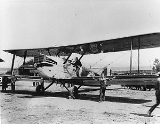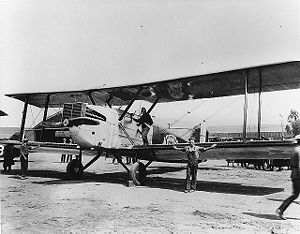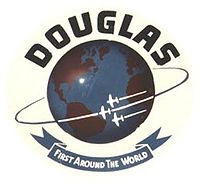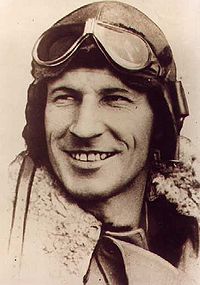
First aerial circumnavigation
Encyclopedia

United States Army Air Service
The Air Service, United States Army was a forerunner of the United States Air Force during and after World War I. It was established as an independent but temporary wartime branch of the War Department by two executive orders of President Woodrow Wilson: on May 24, 1918, replacing the Aviation...
, the precursor of the United States Air Force
United States Air Force
The United States Air Force is the aerial warfare service branch of the United States Armed Forces and one of the American uniformed services. Initially part of the United States Army, the USAF was formed as a separate branch of the military on September 18, 1947 under the National Security Act of...
. The trip took 175 days, covering over 44000 kilometres (27,340 mi), without crossing the equator
Equator
An equator is the intersection of a sphere's surface with the plane perpendicular to the sphere's axis of rotation and containing the sphere's center of mass....
into the southern hemisphere
Southern Hemisphere
The Southern Hemisphere is the part of Earth that lies south of the equator. The word hemisphere literally means 'half ball' or "half sphere"...
.
In 1929 Australian Charles Kingsford Smith
Charles Kingsford Smith
Sir Charles Edward Kingsford Smith MC, AFC , often called by his nickname Smithy, was an early Australian aviator. In 1928, he earned global fame when he made the first trans-Pacific flight from the United States to Australia...
would complete the first aerial circumnavigation
Circumnavigation
Circumnavigation – literally, "navigation of a circumference" – refers to travelling all the way around an island, a continent, or the entire planet Earth.- Global circumnavigation :...
flying within both hemispheres, in an expedition which also included the first trans-Pacific flight in 1928.
US preparation for Northern Hemisphere circumnavigation
In the early 1920s several countries were vying to be the first to fly an airplane around the world. In the spring of 1923 the U.S. Army Air Service became interested in having a squadronSquadron (aviation)
A squadron in air force, army aviation or naval aviation is mainly a unit comprising a number of military aircraft, usually of the same type, typically with 12 to 24 aircraft, sometimes divided into three or four flights, depending on aircraft type and air force...
of military planes make a round-the-world flight. It assigned a group of officers the job of finding a suitable aircraft and planning the mission. The group first looked at the existing pool of military planes, none proved satisfactory, so they began looking outside of the Air Service for a plane that could be fitted with interchangeable landing gear, wheeled and pontoons for water landings. The War Department
United States Department of War
The United States Department of War, also called the War Department , was the United States Cabinet department originally responsible for the operation and maintenance of the United States Army...
instructed the Air Service to look at both the Fokker F-5 transport and the Davis-Douglas Cloudster to see if either would qualify and to acquire examples for testing.
When the head of Davis-Douglas, Donald Douglas
Donald Wills Douglas, Sr.
Donald Wills Douglas, Sr. was a United States aircraft industrialist and founder of the Douglas Aircraft Company in 1921 .-Early life:...
, was asked for information on the Cloudster he instead submitted data on a modified DT-2
Douglas DT
|-References:* René Francillon, "McDonnell Douglas Aircraft Since 1920: Volume I", ISBN 0-87021-428-4...
, a torpedo bomber
Torpedo bomber
A torpedo bomber is a bomber aircraft designed primarily to attack ships with aerial torpedoes which could also carry out conventional bombings. Torpedo bombers existed almost exclusively prior to and during World War II when they were an important element in many famous battles, notably the...
that Douglas had built for the U.S. Navy in 1921 and 1922. The DT-2 had proven to be a sturdy aircraft that could accommodate interchangeable wheeled and pontoon landing gear. Since the plane was an existing model, Douglas stated that a new fleet of planes, which he named the Douglas World Cruiser, could be delivered within 45 days after a contract was awarded. The Air Service agreed and sent Lieutenant Erik Nelson
Erik Nelson
Erik Nelson is an American songwriter and music producer. He is also, alongside Emile Ghantous, a founding member of the songwriting/music production duo The Insomniax.Erik Nelson was the owner of a local recording studio...
, a member of the planning group, to California to work out the details with Douglas.
Douglas, assisted by John Northrop
John Knudsen Northrop
John Knudsen "Jack" Northrop was an American aircraft industrialist and designer, who founded the Northrop Corporation in 1939.-Entering aviation:...
, began to modify a DT-2 to suit the circumnavigation requirements. The main modification involved its fuel capacity. All the internal bomb carrying structures were removed and additional fuel tanks were added to various parts of the plane. The total fuel capacity went from 115 gallons (435 liters) to 644 gallons (3,438 liters).
Lieutenant Nelson took Douglas' proposal to Washington where Major General
Major General
Major general or major-general is a military rank used in many countries. It is derived from the older rank of sergeant major general. A major general is a high-ranking officer, normally subordinate to the rank of lieutenant general and senior to the ranks of brigadier and brigadier general...
Mason M. Patrick, Chief of the Air Service, approved it on August 1, 1923. The War Department awarded an initial contract to Douglas for the construction of a single test plane. The test plane met all expectations, and a contract was awarded for four more planes and spare parts. The last plane was delivered on March 11, 1924. The spare parts included 15 extra Liberty
Liberty L-12
The Liberty L-12 was a 27 litre water-cooled 45° V-12 aircraft engine of 400 horsepower designed both for a high power-to-weight ratio and for ease of mass production.-History:...
engines, 14 extra sets of pontoons, and enough replacement airframe parts for two more planes. These were sent ahead along the route around the world the planes would follow.
The northern hemisphere circumnavigation

Santa Monica, California
Santa Monica is a beachfront city in western Los Angeles County, California, US. Situated on Santa Monica Bay, it is surrounded on three sides by the city of Los Angeles — Pacific Palisades on the northwest, Brentwood on the north, West Los Angeles on the northeast, Mar Vista on the east, and...
, on March 17, 1924, for Seattle, Washington
Seattle, Washington
Seattle is the county seat of King County, Washington. With 608,660 residents as of the 2010 Census, Seattle is the largest city in the Northwestern United States. The Seattle metropolitan area of about 3.4 million inhabitants is the 15th largest metropolitan area in the country...
the official start of the journey. On April 6 they left Seattle for Alaska
Alaska
Alaska is the largest state in the United States by area. It is situated in the northwest extremity of the North American continent, with Canada to the east, the Arctic Ocean to the north, and the Pacific Ocean to the west and south, with Russia further west across the Bering Strait...
. One plane, Seattle, needed repairs and remained behind. When it was repaired the crew attempted to catch up with the other three planes, but on April 30 Seattle crashed in dense fog into a mountainside near Port Moller on the Alaska Peninsula
Alaska Peninsula
The Alaska Peninsula is a peninsula extending about to the southwest from the mainland of Alaska and ending in the Aleutian Islands. The peninsula separates the Pacific Ocean from Bristol Bay, an arm of the Bering Sea....
. The crew survived and were picked up on May 10, but the plane was destroyed.
The three remaining planes continued. Avoiding the Soviet Union
Soviet Union
The Soviet Union , officially the Union of Soviet Socialist Republics , was a constitutionally socialist state that existed in Eurasia between 1922 and 1991....
, which had not given permission for the planes to cross into their airspace, they crossed Japan
Japan
Japan is an island nation in East Asia. Located in the Pacific Ocean, it lies to the east of the Sea of Japan, China, North Korea, South Korea and Russia, stretching from the Sea of Okhotsk in the north to the East China Sea and Taiwan in the south...
, Korea
Korea
Korea ) is an East Asian geographic region that is currently divided into two separate sovereign states — North Korea and South Korea. Located on the Korean Peninsula, Korea is bordered by the People's Republic of China to the northwest, Russia to the northeast, and is separated from Japan to the...
, the coast of China
China
Chinese civilization may refer to:* China for more general discussion of the country.* Chinese culture* Greater China, the transnational community of ethnic Chinese.* History of China* Sinosphere, the area historically affected by Chinese culture...
, Hong Kong
Hong Kong
Hong Kong is one of two Special Administrative Regions of the People's Republic of China , the other being Macau. A city-state situated on China's south coast and enclosed by the Pearl River Delta and South China Sea, it is renowned for its expansive skyline and deep natural harbour...
, French Indochina
French Indochina
French Indochina was part of the French colonial empire in southeast Asia. A federation of the three Vietnamese regions, Tonkin , Annam , and Cochinchina , as well as Cambodia, was formed in 1887....
, Thailand
Thailand
Thailand , officially the Kingdom of Thailand , formerly known as Siam , is a country located at the centre of the Indochina peninsula and Southeast Asia. It is bordered to the north by Burma and Laos, to the east by Laos and Cambodia, to the south by the Gulf of Thailand and Malaysia, and to the...
, Burma, and India
India
India , officially the Republic of India , is a country in South Asia. It is the seventh-largest country by geographical area, the second-most populous country with over 1.2 billion people, and the most populous democracy in the world...
, and proceeded into the Middle East
Middle East
The Middle East is a region that encompasses Western Asia and Northern Africa. It is often used as a synonym for Near East, in opposition to Far East...
and then Europe
Europe
Europe is, by convention, one of the world's seven continents. Comprising the westernmost peninsula of Eurasia, Europe is generally 'divided' from Asia to its east by the watershed divides of the Ural and Caucasus Mountains, the Ural River, the Caspian and Black Seas, and the waterways connecting...
. They arrived in Paris
Paris
Paris is the capital and largest city in France, situated on the river Seine, in northern France, at the heart of the Île-de-France region...
on Bastille Day
Bastille Day
Bastille Day is the name given in English-speaking countries to the French National Day, which is celebrated on 14 July of each year. In France, it is formally called La Fête Nationale and commonly le quatorze juillet...
, July 14. From Paris they flew to London
London
London is the capital city of :England and the :United Kingdom, the largest metropolitan area in the United Kingdom, and the largest urban zone in the European Union by most measures. Located on the River Thames, London has been a major settlement for two millennia, its history going back to its...
and on to the north of England
England
England is a country that is part of the United Kingdom. It shares land borders with Scotland to the north and Wales to the west; the Irish Sea is to the north west, the Celtic Sea to the south west, with the North Sea to the east and the English Channel to the south separating it from continental...
in order to prepare for the Atlantic Ocean
Atlantic Ocean
The Atlantic Ocean is the second-largest of the world's oceanic divisions. With a total area of about , it covers approximately 20% of the Earth's surface and about 26% of its water surface area...
crossing.
On August 3, while flying across the Atlantic, Boston was forced down and capsized while being towed by a cruiser
Cruiser
A cruiser is a type of warship. The term has been in use for several hundreds of years, and has had different meanings throughout this period...
that had picked up the crew. The
Chicago with Lowell Smith and Leslie Arnold, and the New Orleans, with Erik Nelson and Jack Harding, continued and crossed the Atlantic via Iceland
Iceland
Iceland , described as the Republic of Iceland, is a Nordic and European island country in the North Atlantic Ocean, on the Mid-Atlantic Ridge. Iceland also refers to the main island of the country, which contains almost all the population and almost all the land area. The country has a population...
and Greenland
Greenland
Greenland is an autonomous country within the Kingdom of Denmark, located between the Arctic and Atlantic Oceans, east of the Canadian Arctic Archipelago. Though physiographically a part of the continent of North America, Greenland has been politically and culturally associated with Europe for...
and reached Canada
Canada
Canada is a North American country consisting of ten provinces and three territories. Located in the northern part of the continent, it extends from the Atlantic Ocean in the east to the Pacific Ocean in the west, and northward into the Arctic Ocean...
. The original test plane, now named Boston II, met them in Canada and the three planes flew on to Washington DC. After a hero's welcome in the capital, the three planes flew to the West Coast, stopping briefly in Santa Monica and finally landing in Seattle on September 28, 1924.
The trip had taken 175 days, and covered
27,553 miles (44,085 km). The Douglas Aircraft Company
Douglas Aircraft Company
The Douglas Aircraft Company was an American aerospace manufacturer, based in Long Beach, California. It was founded in 1921 by Donald Wills Douglas, Sr. and later merged with McDonnell Aircraft in 1967 to form McDonnell Douglas...
adopted the motto, "First Around the World – First the World Around". The American team had greatly increased their chances of success by using several planes and prepositioning large caches of spare parts and other support along the route.
The world circumnavigation

Southern Cross (aircraft)
Southern Cross is the name of the Fokker F.VIIb/3m trimotor monoplane which in 1928 was flown by Australian aviator Sir Charles Kingsford Smith and his crew in the first ever trans-Pacific flight, from the mainland United States to Australia, about ....
,
a Fokker
Fokker
Fokker was a Dutch aircraft manufacturer named after its founder, Anthony Fokker. The company operated under several different names, starting out in 1912 in Schwerin, Germany, moving to the Netherlands in 1919....
F.VIIb/3m
Fokker F.VII
The Fokker F.VII, also known as the Fokker Trimotor, was an airliner produced in the 1920s by the Dutch aircraft manufacturer Fokker, Fokker's American subsidiary Atlantic Aircraft Corporation, and other companies under licence....
trimotor
Trimotor
A trimotor is an aircraft powered by three piston engines.Trimotor designs were relatively common in the early days of aviation, as engines were less powerful and less reliable.-Notable types:* Armstrong Whitworth Argosy...
monoplane
Monoplane
A monoplane is a fixed-wing aircraft with one main set of wing surfaces, in contrast to a biplane or triplane. Since the late 1930s it has been the most common form for a fixed wing aircraft.-Types of monoplane:...
.
After completing the first trans-Pacific crossing in 1928, flying from Oakland to Brisbane
Brisbane
Brisbane is the capital and most populous city in the Australian state of Queensland and the third most populous city in Australia. Brisbane's metropolitan area has a population of over 2 million, and the South East Queensland urban conurbation, centred around Brisbane, encompasses a population of...
, Charles Kingsford Smith
Charles Kingsford Smith
Sir Charles Edward Kingsford Smith MC, AFC , often called by his nickname Smithy, was an early Australian aviator. In 1928, he earned global fame when he made the first trans-Pacific flight from the United States to Australia...
and Charles Ulm
Charles Ulm
Charles Thomas Philippe Ulm AFC was a pioneer Australian aviator.-World War I:Ulm joined the AIF in September 1914, lying about his name and age to get in. He fought and was wounded at Gallipoli in 1915, and on the Western Front in 1918.Charles Ulm was married twice. In 1919 he married Isabel...
spent several months making other long-distance flights across Australia and to New Zealand. They decided to use their trans-Pacific flight as the first leg of a globe-circling flight. They flew the Southern Cross to England, then across the Atlantic and North America, returning to Oakland where their trans-Pacific flight had begun. The first cross equator world circumnavigation flight was completed in 1929.
North hemisphere aircraft and crew
- Seattle, Maj. Frederick Martin (pilot and flight commander) and SSgt.Staff SergeantStaff sergeant is a rank of non-commissioned officer used in several countries.The origin of the name is that they were part of the staff of a British army regiment and paid at that level rather than as a member of a battalion or company.-Australia:...
Alva Harvey (flight mechanic); - Chicago, Lt. Lowell SmithLowell SmithLowell Herbert Smith was a pioneer American airman who piloted the first airplane to receive a complete mid-air refueling on June 27, 1923, and later set an endurance record of 37 hours on August 28, both in a De Havilland DH-4B...
(pilot) and 1st Lt. Leslie Arnold; - Boston, 1st Lt. Leigh P. Wade (pilot) and SSgt. Henry H. Ogden;
- New Orleans, Lt. Erik Nelson (pilot) and Lt. Jack Harding.
Chicago was restored in 1971–1974 and moved into the National Air and Space Museum
National Air and Space Museum
The National Air and Space Museum of the Smithsonian Institution holds the largest collection of historic aircraft and spacecraft in the world. It was established in 1976. Located in Washington, D.C., United States, it is a center for research into the history and science of aviation and...
in 1976.
New Orleans is owned by Los Angeles County
Los Angeles County, California
Los Angeles County is a county in the U.S. state of California. As of 2010 U.S. Census, the county had a population of 9,818,605, making it the most populous county in the United States. Los Angeles County alone is more populous than 42 individual U.S. states...
and is on loan to the Museum of Flying
Museum of Flying
-History:Originally founded in 1974 by Donald Douglas Jr. as the Douglas Museum and Library located on the South side of the Santa Monica Airport, the Museum migrated to the North side of the Airport and reopened as the Museum of Flying in April 1989...
in Santa Monica, California
Santa Monica, California
Santa Monica is a beachfront city in western Los Angeles County, California, US. Situated on Santa Monica Bay, it is surrounded on three sides by the city of Los Angeles — Pacific Palisades on the northwest, Brentwood on the north, West Los Angeles on the northeast, Mar Vista on the east, and...
.
The wreckage of Seattle is on display at the Alaska Aviation Heritage Museum
Alaska Aviation Heritage Museum
The Alaska Aviation Heritage Museum is located in Anchorage, Alaska. Its mission is to preserve, display, and honor Alaska's aviation heritage, by preserving and displaying historic aircraft, artifacts, and memorabilia, and to foster public interest in aviation and its history...
.
Major Martin was in command of Army aviation units in Hawaii
Hawaii
Hawaii is the newest of the 50 U.S. states , and is the only U.S. state made up entirely of islands. It is the northernmost island group in Polynesia, occupying most of an archipelago in the central Pacific Ocean, southwest of the continental United States, southeast of Japan, and northeast of...
at the time of the Japanese attack of December 7, 1941
Attack on Pearl Harbor
The attack on Pearl Harbor was a surprise military strike conducted by the Imperial Japanese Navy against the United States naval base at Pearl Harbor, Hawaii, on the morning of December 7, 1941...
. His mechanic Alva Harvey was commissioned and commanded heavy bomb groups
USAAF bombardment group
A bombardment group or bomb group was a group of bomber aircraft the United States Army Air Forces during World War II. It was the equivalent of an infantry regiment in the Army Ground Forces, or a bomber wing in the British Commonwealth air forces...
during the Second World War. Lt. Nelson rose to the rank of colonel
Colonel
Colonel , abbreviated Col or COL, is a military rank of a senior commissioned officer. It or a corresponding rank exists in most armies and in many air forces; the naval equivalent rank is generally "Captain". It is also used in some police forces and other paramilitary rank structures...
and became one of General Henry Arnold's chief trouble-shooters on the development and employment of the B-29 Superfortress
B-29 Superfortress
The B-29 Superfortress is a four-engine propeller-driven heavy bomber designed by Boeing that was flown primarily by the United States Air Forces in late-World War II and through the Korean War. The B-29 was one of the largest aircraft to see service during World War II...
.
World aircraft and crew

- Southern Cross, Charles Kingsford Smith (lead pilot), Charles Ulm (relief pilot), James WarnerJames Warner (aviator)James Warner is noted as the radio operator on the aircraft Southern Cross piloted by Sir Charles Kingsford Smith for the first trans-Pacific flight in 1928, during which radio was first used successfully on a long distance flight.-Early life:...
(radio operator), and Harry LyonHarry Lyon (aviator)Harry Lyon , was the navigator for the first flight across the Pacific in 1928 with Charles Kingsford Smith , Charles Ulm and fellow-American James Warner as the in the Southern Cross....
(navigator and engineer).
Before Kingsford Smith's death in 1935 he donated the Southern Cross to the Commonwealth of Australia, for display in a museum. The aircraft is preserved in a special glass 'hangar
Hangar
A hangar is a closed structure to hold aircraft or spacecraft in protective storage. Most hangars are built of metal, but other materials such as wood and concrete are also sometimes used...
' memorial on Airport Drive, near the International Terminal at Brisbane Airport
Brisbane Airport
Brisbane Airport is the sole passenger airport serving Brisbane and the third busiest in Australia, after Melbourne and Sydney Airports. Brisbane Airport has won many awards. Located in the suburb with the same name, the airport serves the city of Brisbane and the surrounding metropolitan area...
in Queensland
Queensland
Queensland is a state of Australia, occupying the north-eastern section of the mainland continent. It is bordered by the Northern Territory, South Australia and New South Wales to the west, south-west and south respectively. To the east, Queensland is bordered by the Coral Sea and Pacific Ocean...
, Australia.

